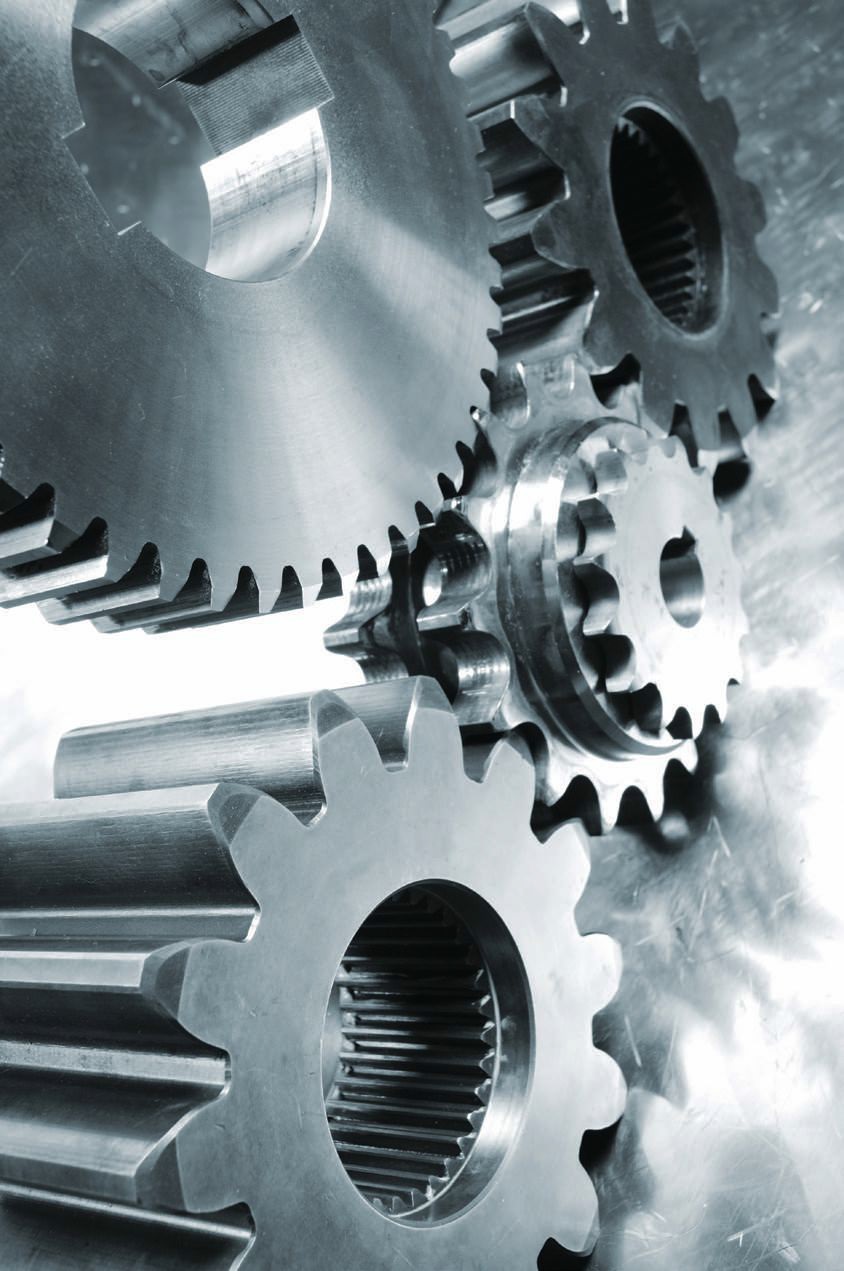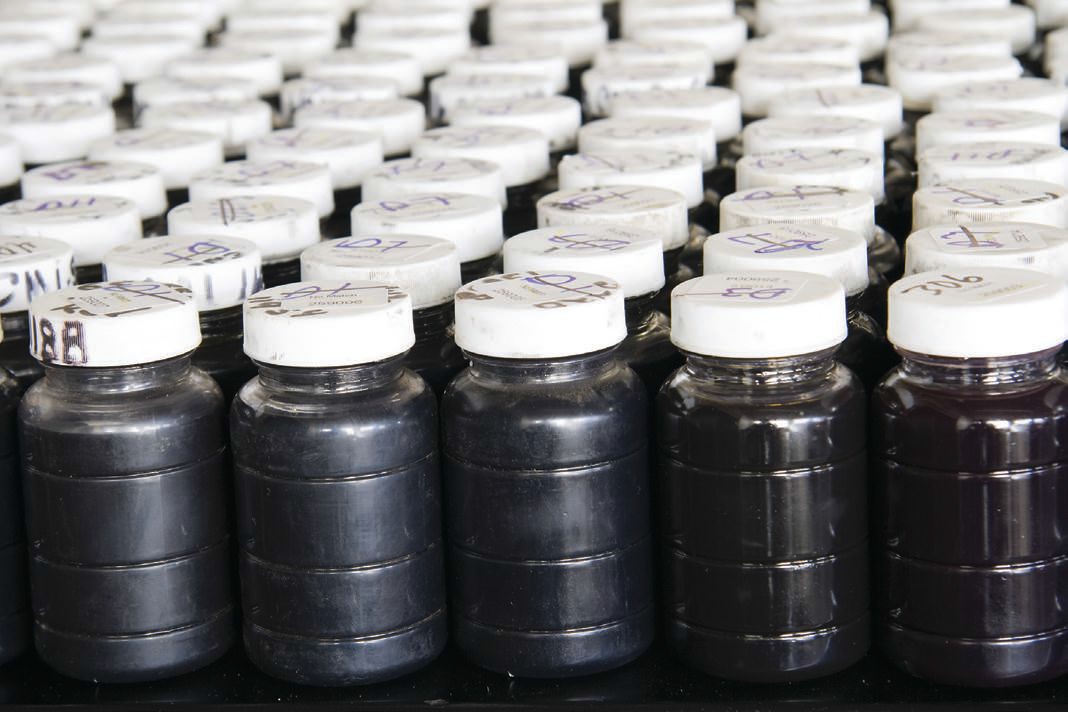Vibration Analysis: The other half of the equation
Jean Van Rensselar, Contributing Editor | TLT Cover Story August 2011
This proven condition monitoring method is an excellent complement to oil analysis in many applications.
KEY CONCEPTS
•
The premise behind vibration analysis is that specific mechanical defects produce characteristic vibrations at different frequencies.
•
Vibration analysis is an excellent complement to oil analysis in some applications.
•
The need for integrated monitoring depends on the applicability of the procedures and the importance of the equipment.
It’s intuitive—if something is obviously wobbling and vibrating that’s not supposed to, it’s not good. This applies to $300 washing machines and $25 million oil rigs.
Every aspect of highly engineered equipment is perfectly balanced and meant to stay that way for a long time. The slightest new vibration is an early warning that something is out of sync and is likely to get worse. While factory workers have known this for two centuries, until the advent of sophisticated vibration analysis, by the time you could see or hear something vibrating it was too late.
Today, most enlightened organizations have a proactive maintenance program in place—monitoring the condition of the equipment well before failure. Oil analysis is one of two major analysis methods, vibration analysis is the other.
In addition to wasting energy and, in the extreme, wearing on the nerves of everyone who has to listen to it for 40-plus hours a week, unusual machine vibration usually indicates impending failure (most vibrations in rotating machinery are caused by either imbalances in the rotating parts, poorly meshing gear teeth or uneven friction).
As oil analysts know, most carefully monitored machines don’t suddenly fail. Well before failure there are anomalies or ominous trends in oil analysis reports. For vibration analysts, those warnings are an increase in the level of vibration at a particular location.
In the same way that oil analysis picks up the presence of particles too small to see with the naked eye, vibration analysis picks up increases in vibration levels that are too slight for the ear to detect or the hand to feel. By monitoring, measuring and analyzing those vibrations, users can often pinpoint the exact cause of the problem and correct it before real damage occurs.
Vibration analysis and oil analysis are rarely performed together, but experts say there are definite benefits to doing so in some applications—like gearboxes, reciprocating combustion engines and hydraulic systems where they create a very accurate and complete picture of equipment health.
Like oil analysis, vibration analysis allows users to evaluate equipment condition and (it is hoped) avoid failure. The sooner the problem is detected and fixed, the less expensive it is to repair.
 The idea behind vibration analysis is that each piece of equipment has its own unique vibration signature.
The idea behind vibration analysis is that each piece of equipment has its own unique vibration signature.
www.canstockphoto.com
VIBRATION ANALYSIS
The idea behind vibration analysis is that each piece of equipment has its own unique vibration signature. Once that signature is established, any variation is cause for concern. Mechanical defects produce characteristic vibrations at different frequencies. Specific vibrations relate to specific machine fault conditions. For example, when bearings and components reach the end of their lifecycles, they begin to vibrate more dramatically and distinctly. By using signal- processing technology to analyze the time and frequency spectrums, monitoring equipment can identify the defect and natural frequencies of targeted structural components.
Rotating structures are prime candidates for vibration analysis with their constant but arbitrary velocity in elements such as rotor shafts and propeller blades (wind turbines and helicopters). Most rotating machine failures are rooted in imbalances. The center of mass is not in sync with the center of rotation, which is especially rough on the bearings that are critical to the smooth operation and longevity of equipment.
Vibration analysis is also excellent for diagnosing the condition of complex machinery such as multistage gearboxes, turbine/generators and AC and DC motors. On the other hand, there are a number of machines that can’t be adequately analyzed with vibration monitoring alone, these include diesel engines, piston type hydraulic pumps and reciprocating air compressors.
Bill Marscher is president and technical director of Mechanical Solutions, Inc., in Whippany, N.J., and also a past president of STLE and an STLE Fellow. He says, “Because they want to get very early warning of impending reliability problems—and vibration analysis typically does this best—the refinery/petrochemical, power generation and water/wastewater industries often rely more on vibration analysis than they do on oil analysis.”
There are two types of vibration. Free vibration occurs when movement in a mechanical system is initiated by an outside force. The mechanical system vibrates freely for a time but then invariably stops. Forced vibration occurs when an irregular force impacts a mechanical system—most often creating an imbalance. The frequency of the vibration and the frequency of the applied force are the same, but the magnitude depends on the structure of the mechanical system.
One of the advantages of vibration analysis is the ability to stave off damage by predicting when a specific type of vibration will occur before the fact and letting users know how to prevent it from happening. For very expensive pieces of equipment, the cost savings of this analysis methodology are significant.
TEST OPTIONS
Vibration analysis used to be as primitive as dialing an instrument to identify frequencies where vibration was prominent. All the user had to do was compare peak frequencies with operating speed. The final step was consulting the manufacturer’s chart for possible causes. While this method left a lot of room for error and interpretation, it created a close link between the user and the equipment—allowing experienced users to sense exactly what was amiss without looking at the chart.
The current generation of vibration analysis equipment and software predict developing problems with remarkably accuracy. In fact, this equipment can display a full spectrum of vibration across three axes at once. But as with oil analysis, the plethora of cutting-edge software-based capabilities and features still require a basic understanding of vibration analysis to reap the full benefits.
The core tool for analyzing vibrations is the FFT (Fast Fournier Transformation) spectrum analyzer, which was developed in the mid-1970s. This tool samples the input signal, computes the magnitude of its sine and cosine parameters and then displays the spectrum of these measured frequency components. The primary advantage over analog spectrum analyzers is speed—up to several hundred times faster.
In the early 1980s, FFT spectrum analyzers became available in portable, handheld versions. Paired with software for condition monitoring data collecting and analysis, these were very powerful tools. Not surprisingly, the number of companies instituting vibration analysis to diagnose areas like imbalances, misalignments and bearing defects grew exponentially. These FFT analyzers continue to evolve, detecting peaks at higher and higher frequencies.
As vibration analysis becomes more sophisticated and training thus becomes more complex, organizations too small to justify the cost of in-house equipment and staff training opt to outsource vibration monitoring, analysis and reporting.
Some vibration analysis companies, like Marscher’s, perform on-site detailed vibration analysis of high-value rotating machinery—a very valuable service for many customers. One of Marscher’s customers in Trinidad had a steam turbine that was making an alarming noise with associated shaking about every 10 minutes. To simply shut down and disassemble the turbine to determine the root cause would have taken several weeks at a cost of $250,000 per day, Marscher figures. Detailed vibration analysis was able to determine exactly what the internal problem was and provide the basis for a confident recommendation that continued operation until the plant’s scheduled turnaround would not result in machinery failure. Because of this, the plant was able to continue operation during its high-production period and save about $8 million, Marscher explains.
Choosing machinery to monitor: The Criticality Index
The Criticality Index determines the logical extent of condition monitoring required for a piece of equipment. It takes into account such factors as:
•
The importance of the machine’s function.
•
Whether or not there is another piece of equipment that can take over the function if that piece of machinery fails.
•
The overall impact of downtime.
•
The projected repair cost.
This index assigns all machines to one of the following three categories:
1. Critical Machinery: These are machines that are so important that the rest of the operating environment can’t function without them, i.e., power plant turbines. Equipment in this category requires complete online and (where possible) inline condition monitoring, regardless of cost. The specifics of monitoring are often included in insurance policies and warranties. These pieces of equipment are prime candidates for predictive maintenance.
2. Essential Machinery: This equipment is key to the operating environment, but its failure does not cripple operations. Sometimes equipment that falls in this category would be considered critical if not for the fact that a backup piece of equipment is readily available. While testing is not as important as it is with critical machinery, it is recommended to circumvent costly repairs and inconvenience.
3. General Purpose Machinery: The balance of operations equipment is in this category. These machines are usually monitored informally and periodically.
DATA COLLECTION AND INTERPRETATION
A complete vibration analysis requires a full-spectrum vibration profile on horizontal, vertical and axial axes—on both ends of the motor and the full piece of equipment. Some problems only show up on one axis. If maintenance workers take a reading on only one axis (as they often do) they’ll miss a pending failure on another axis.
Since not all equipment operates at the same speed, looking at the vibration signature in relation to multiples of the rotating speed will simplify analysis. Rotor imbalance, for instance, usually shows up at rotating speed; while mechanical problems—such as a bent shaft, a bad coupling or an oversized bearing housing— tend to appear at 2x rpm (
1).
Vibration frequencies at higher multiples of the rotating speed correspond with the number of components in a specific rotating part, such as the number of balls in a bearing.
Vibration needs to be examined when the natural frequency of the entire assembly suddenly becomes close to the vibrating frequency of one part. This is most likely to occur when a new part with slightly different dimensions than the part it’s replacing is installed. Other causes of a frequency change are early structural damage or failure.
Variable-frequency drives make interpreting data more difficult, since inverter-driven induction motors tend to operate significantly below the manufacturer’s recommended speed. Frequency variation also makes electrical problems more difficult to diagnose.
Since concrete is prone to deterioration (especially when it’s exposed to outdoor extremes), a defective foundation should always be one of the first considerations. Axis-specific problems caused by a problem related to the machinery’s base are indicated by a high vertical reading. This may signify loose base-bolts, a loose structure or a separating sole plate. High horizontal readings are commonly associated with imbalance in the rotating elements.
High axial readings generally indicate misalignment. The cause may be external, like coupling misalignment, or internal, like a bent shaft. Looseness may be caused by a worn coupling, an oversized bearing housing or—with a sleeve bearing motor—excess bearing-to-shaft clearance (
2).
Experts suggest keeping a file on critical equipment, especially complex machinery. The file should include information on bearing brands and sizes, fan blades and rotor bars and a count of gear teeth.
Pairing vibration analysis with oil analysis is becoming more common in some industries and applications. Where there is expensive and/or complex machinery, vibration analysis combined with oil analysis is a must.
 Vibration analysis picks up increases in vibration levels that are too slight for the ear to detect or the hand to feel.
Vibration analysis picks up increases in vibration levels that are too slight for the ear to detect or the hand to feel.
www.canstockphoto.com
TEST SYNERGY
Vibration analysis and oil analysis are widely acknowledged as the best methods for monitoring equipment. The two techniques feature complementary strengths. Basically, vibration analysis monitors and controls balance, alignment and looseness, while oil analysis monitors lubricant quality and contamination, wear metals and alloys, rate of wear and also qualifies the type and size of wear particles generated through the use of analytical ferrography. Oil analysis does not control lubricant quality or contamination. Sometimes one technique will indicate a vague problem that the other can pinpoint.
Vibration analysis is an excellent technology for detecting certain types of issues in certain types of equipment. It’s best at detecting failures in high-speed bearing systems and often better than oil analysis at specifying the point of failure. While oil analysis cannot detect resonance, vibration analysis can.
In other applications, oil analysis alone will produce adequate and accurate results. Oil analysis is generally better at uncovering failures in gearboxes, reciprocating equipment and hydraulic systems. It’s also better at determining which wear mechanism is causing the failure. Vibration analysis has limited success in detecting oil lubricated bearing wear, whereas oil analysis does this spectacularly.
Oil analysis excels at providing clear and timely information on specific types of wear and equipment conditions. It’s the best indicator of gear problems and more effective than vibration analysis for motors bigger than 1,000 HP—one reason why it’s the technology of choice for fleet industries. In many cases, oil analysis is the leading indicator of existing and ongoing machine wear. Because vibration analysis doesn’t monitor low-speed machinery well, oil analysis is the better choice in those applications.
Mark Minges, chief operating officer for POLARIS Laboratories® in Indianapolis, says, “Oil analysis provides an earlier means of detection and can identify wear and contamination issues, fluid degradation or confirm that the wrong lubricant is being used—i.e., a hydraulic fluid has been used in a system requiring gear oil.”
“In a gearbox, oil analysis can tell you a gear is wearing, but vibration analysis can pinpoint which gear in a gearset where multiple gearsets are lubricated by a common reservoir,” Minges adds. “Vibration analysis can detect where a problem is occurring (a defect with a specific bearing or gear) and can identify mechanical problems such as improper alignment or situations where the equipment is not properly secured or bolted down.”
When both technologies are used in conjunction and pinpoint the same problem, the diagnosis and follow-up recommendations are nearly always accurate. Often one technology will pinpoint or predict the specific problem area while the other will pinpoint or predict the type of failure.
Although the correlation between oil analysis and vibration analysis is generally strong, sometimes one test indicates a problem and the other does not (or they contradict each other). The negative correlation between sliding wear and vibration rate is an example. Another example is a fractured gear tooth, which vibration analysis can easily detect, but because of the large fragment size, oil analysis usually cannot.
Marscher says that imbalance and misalignment account for roughly 80% of machinery shaking problems and associated bearing, seal and coupling failures. “Vibration analysis is ideal for identifying imbalance and most situations of misalignment,” he says. “Oil analysis also can pick up these problems if they lead to excessive force at the bearings which is often—but not always—the case. Even when oil analysis picks these issues up, however, it typically will not do so as quickly as appropriate types of vibration monitoring can.
“Also, vibration can be evaluated in terms of its ‘frequency content,’ which provides direct clues concerning what the specific reason for the problem is, Marscher adds. “For example, if the vibration frequency is 1x running speed, it is very likely that the vibration is due to imbalance. Vibration analysis generally picks up rubbing impact problems better than other forms of condition monitoring unless the rub and/or impact is in the bearing, in which case oil analysis would also be a good indicator.”
However, Minges adds that, “Rubbing wear can be detected at very early stages through wear debris analysis such as analytical ferrography.”
 Rotating structures are prime candidates for vibration analysis.
Rotating structures are prime candidates for vibration analysis.
www.canstockphoto.com
JOINT OIL & VIBRATION ANALYSIS
The Palo Verde Nuclear Generating Station in Wintersburg, Ariz., pioneered the integration of the two condition monitoring technologies. Facility personnel combined both analyses into a single division and brought its oil analysis on-site. After conducting a results assessment, the researchers concluded that oil analysis was responsible for 40% of the defects found, vibration analysis was responsible for 33%, and both techniques converged on the remaining 27% of the defects found.
The predictive maintenance department documented approximately $3.7 million in savings in one year. Over a three-year period, they figured that for every dollar spent on these condition monitoring techniques, they saved at least $6.50 in maintenance costs (
3).
The School of Engineering at Australia’s James Cook University conducted a research project to investigate the correlation between vibration analysis and wear debris analysis. The school’s researchers built an experimental worm gearbox driven by an electric motor. The choice of a worm gear for this study was designed to mimic real-world conditions—both rolling and/or sliding wear processes are common in industrial rotating equipment. This would allow the replication of both types of mechanical friction in one experimental test rig. They then conducted a series of studies on the device, utilizing different machine defect conditions under controlled operating conditions. Wear debris analysis data was then compared with vibration analysis data in order to quantify the effectiveness of both vibration analysis and wear debris analysis in predicting and diagnosing equipment conditions.
They employed proven wear debris analysis technologies—a high-quality particle analyzer, a confocal laser scanning microscope (CLSM) and an electron probe microanalyzer. Three tests were conducted under the following conditions:
Test 1: Normal operation
Test 2: Lack of proper lubrication
Test 3: Contaminant particles in the lubricating oil
Oil samples and vibration data were collected regularly. Wear debris analysis included the study of particle concentration and size distributions, along with the examination of particle morphology and types to determine possible wear mechanisms, wear rates and wear sources. Vibration analysis consisted of analyzing both the time and frequency vibration signals from the test rig to determine the onset and severity of active wear, and to help diagnose the root cause (
4).
Researchers collected an oil sample each week from each of the three tests during 18 weeks. Each oil sample was scrutinized and compared. A particle analyzer was used to determine oil sample particle concentrations in order to assess gearbox condition trends. Both wear debris and vibration analysis techniques were used to assess the gearbox condition and diagnose problems during the three tests.
Following are the results:
Test 1: The results from wear debris analysis indicated a normal condition with a slightly high number of wear particles due to roughening gear surfaces near the end of the test.
Test 2: Both methods discovered the lack of lubrication problem between the gear surfaces, although the wear particle analysis gave a more conclusive result. The presence of severe sliding particles from metal-to-metal sliding was a good indicator of inadequate lubrication.
Test 3: Wear debris analysis found a large number of wear particles with a relatively smooth surface. Because iron powder was involved in the wear process and its form was modified, the wear process may be called a three-body rubbing wear process. In contrast to normal three-body wear processes, which include hard contaminants such as sand, the three-body wear process in this study did not generate cutting particles associated with cutting wear. It did, however, generate significant wear debris. The iron particles accelerated the wear process. Vibration analysis confirmed the wear process due to the increase in the peak at the shaft running speed, and the presence of a mound of energy near the bearing frequency (
5).
Researchers concluded that vibration analysis provided quick and reliable information on bearing condition, and wear debris analysis provided solid information on the wear rate and gear mechanism. Integration of these two condition monitoring techniques in all three worm gearbox tests provided a nearly complete picture of the operating condition.
Marscher says, “Combined vibration plus oil analysis is ideal for applications where sliding is inherent in the system. For example, reciprocating piston rings or where bearing stiffness is extremely high—machine tools are a good example.”
Creating an integrated condition monitoring program
After selecting technologies and developing a strategy, the condition monitoring team must be organized to implement these technologies effectively. An audit document provides a good framework if it spells out how to:
•
Evaluate the knowledge and experience of condition monitoring team members.
•
Assess the condition monitoring training these individuals have received.
•
Evaluate condition monitoring instruments and software tools currently in use.
•
Appraise the effectiveness of each of the condition monitoring technologies implemented.
Once that framework is in place, it will be most successful if:
1. The entire condition monitoring team performing all technologies has been brought into one common area—allowing free information transfer and improvement in the accuracy and reliability of diagnostic decisions as well as root cause analysis.
2. All condition monitoring personnel report to a single plant program manager who directly reports to plant management.
3. All condition monitoring personnel are cross-trained in at least one other condition monitoring technology, giving them greater confidence and a more complete perspective.
4. All condition monitoring personnel work full-time in their field (they may occasionally assist in performing certain corrective actions but are not expected to do this on a regular basis).
5. All condition monitoring personnel receive formal training in their areas of expertise at least one week per year in order to keep them up-to-date and to further advance their knowledge.
Source: James E. Berry, P.E., Technical Associates of Charlotte (6)
SPECIFIC APPLICATIONS
Some applications are better candidates for integrated condition monitoring than others. Three that are of particular interest to tribologists are gearboxes, reciprocating combustion engines and hydraulic systems.
Gearboxes. The most common gearbox failure modes are gear tooth fractures and wear. Vibration analysis has trouble picking up these failures because they involve a cacophony of signals. Oil analysis, on the other hand, can easily detect wear (abrasive and adhesive) and contact fatigue. Then there is the broken gear tooth problem mentioned above—vibration analysis can detect it, oil analysis often cannot because the debris falls to the bottom and never gets included in a sample until it’s oxidized and dissolved metals leach into the oil.
Reciprocating combustion engines. While vibration analysis is the method of choice for monitoring grease-lubricated electric motors, oil analysis has always been the first choice for reciprocating combustion engines. For mobile plants, oil analysis is the primary condition monitoring tool for the entire drivetrain, but for fixed equipment, vibration analysis is useful for monitoring the condition of other parts of the machine train—pumps and generators in particular.
Hydraulic systems. While hydraulic systems vary enormously, oil analysis is the most prevalent technology for monitoring them. But where speed and load can be fixed throughout the sampling procedures, vibration analysis is useful for some pumps and motors.
Oil analysis detects early stage rolling element bearing failures better than vibration analysis, although both tests will detect faults. This is a classic case where, when the two technologies are used together, the results are nearly always accurate. Also, experts agree that both oil analysis and vibration analysis are needed to accurately detect and analyze root cause failure.
OTHER TESTS AND TECHNIQUES
In addition to vibration analysis and oil analysis, there are other tests that are sometimes conducted in conjunction with each other to ascertain equipment condition. These tests include visual inspections, thermography, ultrasonics and performance analysis.
VISUAL INSPECTION
This is the most primitive test, but when conducted by an experienced operator it can be one of the most effective. Issues such as leaking, cracking and rust often are readily apparent. A side benefit is that this is without a doubt the least expensive form of condition monitoring.
 ‘While both vibration analysis and oil analysis have their merits, they are most valuable when used in conjunction with one another.’
‘While both vibration analysis and oil analysis have their merits, they are most valuable when used in conjunction with one another.’
www.canstockphoto.com
THERMOGRAPHY
Although slight surface temperature variations are easy to spot, another more comprehensive option is non-destructive thermography. The basic premise is that heat indicates failing components, particularly electrical contacts and terminals. Thermography also works well for detecting the level of deposit build-up in storage tanks and analyzing the condition of couplings, rollers and high-speed bearings. “Using thermography in conjunction with oil and vibration analysis provides the best diagnostic evaluation,” Minges says.
ULTRASONICS
Digital meters measure high frequency signals from bearings and display the result in dBuVs (decibels per microvolt). Using trend analysis, these values will flag potential bearing defects caused by contact conditions such as rubbing and friction. The dBuV value is also used to predict proper intervals for relubrication. Ultrasound pairs particularly well with vibration analysis.
PERFORMANCE ANALYSIS
This involves comparing actual operating statistics with the manufacturer’s original parameters, which are usually posted on the machine’s nameplate.
There are other intriguing technologies currently in limited use such as motor current analysis and stress wave analysis. On the horizon are embedded wear debris detection sensors and embedded vibration detection sensors that monitor conditions around the clock and continuously supply data, and analysis feedback. If used correctly, this technology has the potential to nearly eliminate failure and downtime caused by gradually occurring conditions.
IN THE END
Many considerations are involved in choosing which condition monitoring method(s) to use, with cost vs. benefit being primary for most organizations. While most condition monitoring providers have traditionally offered one technology, this is changing. Today more companies are offering a full spectrum of tests creating an economy of scale and thus lowering costs to customers.
So how do users decide if a piece of equipment should be tested by more than one method? There are three factors: (1.) the applicability of the test to that type of equipment, (2.) the importance of the equipment to operations and (3.) the equipment’s replacement cost.
When it comes to in-house testing, aside from cost, the main roadblock to employing both oil analysis and vibration analysis simultaneously is that the two methods are typically performed by two disparate divisions—with vibration analysis performed by the condition/vibration monitoring team and oil analysis performed by the lubrication team. This means that technicians in the two areas tend to be isolated from each other. Ideally, both types of analysts should work together in a unified program, with each having a foundational knowledge of the other technology.
Minges concludes, “While both vibration analysis and oil analysis have their merits, they are most valuable when used in conjunction with one another.”
REFERENCES
1.
Plant Services, full article
here.
2.
Ibid
3.
Bryan Johnson, full article
here.
4.
Study particulars
here.
5.
Ibid
6.
Ibid, also referenced
here.
 Jean Van Rensselar heads her own communication/public relations firm, Smart PR Communications, in Naperville, Ill. You can reach her at jean@smartprcommunications.com
Jean Van Rensselar heads her own communication/public relations firm, Smart PR Communications, in Naperville, Ill. You can reach her at jean@smartprcommunications.com.